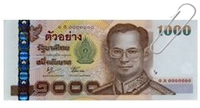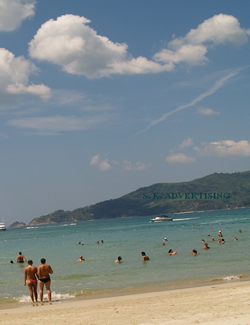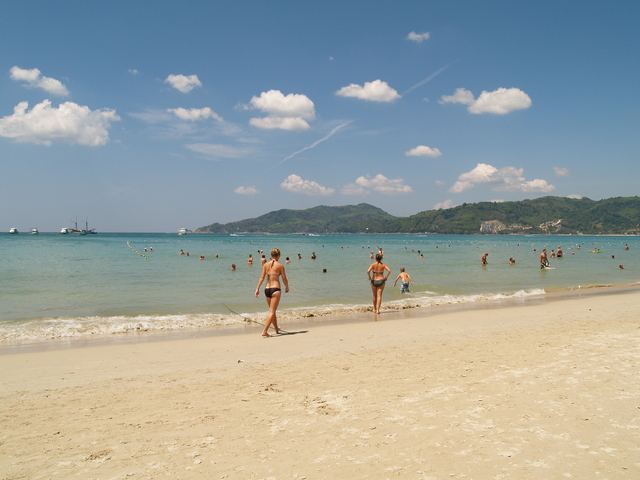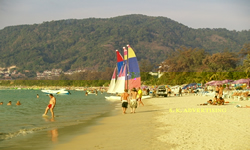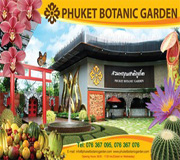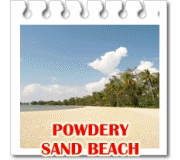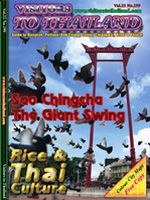Phuket
is Thailand’s largest island, in fact it is a province in southern of
Thailand as well, approximately the size of Singapore (See Map).
Phuket nestles in balmy the Andaman Sea waters on Thailand’s Indian
Ocean coastline 862 kilometers south of the capital, Bangkok.
Phuket formally derives its wealth from tin and rubber, and enjoyed a
rich and colorful history. The island was on one of the major trading
routes between India and China, and was frequently mentioned in foreign
trader’s ship logs.
The Portuguese, French, Dutch and British traded with Phuket. Other
visitors were less friendly. Phuket’s most famous monument is a
memorial statue of 2 heroines-Thao Thep Kasattri and Thao Sri Soonthorn
who rallied islanders in 1785 to repel Burmese invaders.
Phuket is bless with magnificent coves and bays, powdery, palm-fringed
white beaches, sparkling island-dotted seas, sincerely hospitable
people, superb accommodations and excellent sea foods, delightful
turn-of-the century Sino-Portuguese architecture; numerous sporting and
leisure opportunities; a lush tropical landscape, all of which combine
to create a delightful ambience for truly memorable holidays.
Phuket Island has a long recorded history, and remains dating back to
A.D. 1025 indicate that the island’s present day name derives in
meaning from the Tamil, or Crystal Mountain.

Phuket History: For
most of history, however, it was known as Junk Ceylon, which is the
name found on old maps. The name is thought to have its roots in
Ptolemy’s Geographia, written by the Alexandrian geographer in the 3rd Century A.D. He had mentioned that in making a trip from Suvarnabhumi
to the Malay Peninsula it was necessary to pass the cape of Jang Si
Lang.
Phuket was a way station on the route between India and China where
seafarers stopped to shelter. The island appears to have been parted of
the Shivite Empire (called in Thai the Tam Porn Ling) that established
itself on the Malay Peninsula during the first Millennium A.D. Later,
as Muang Takua-Talang, it was parted of Sri Vichai and Siri Tahm
Empires. Governed as the 11th in a constellation
of twelve
cities, Phuket’s emblem, by which it was known to others in those
largely pre-literate times, was the dog.
During the Sukhothai Era, Phuket was associated with Takua Pa in what
is now Phang-Nga province, another area with vast tin reserves. The
Dutch established a trading post during the Ayuddhaya Era in the 16th century. The island’s northern and central regions then were governed
by the Thais, and the southern and western parts were given over to the
tin trade, a concession in the hands of foreigners.
After Ayuddhaya was sacked by the Burmese in 1767 there was a short
interregnum in Thailand, ended by King Taksin, who drove out the
Burmese and re-unified the country. The Burmese, however, were anxious
to return to the offensive. They outfitted a fleet to raid the southern
provinces, and carry off the populations to slavery in Burma.
Thai led Phuket’s most memorable historic event. A passing sea captain,
Francis Light, sent word that the Burmese were en route to attack.
Forces in Phuket were assembled led by the two heroines-Khunying Jan
being wife of Phuket’s recently deceased governor and her sister, Mook
(Thai’s meaning is Pearl). After a month’s siege the Burmese were
forced to depart on 13th March 1785. Khunying
Jan and again her sister were credited with the successful defense.
In recognition King Rama I bestowed upon Khunying Jan the honorific
Thao Thep Kasatri, a title of nobility usually reserved for royalty, by
which she is known today. Her sister became Thao Sri Soonthorn.
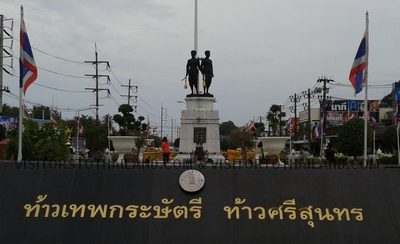
During The 19th century Chinese immigrants arrived in such numbers to work for the tin
mines that the ethic character of the island’s interior became
predominantly Chinese, while the coastal settlements remained populated
chiefly by Muslim fishermen.
In Rama V’s reign, Phuket became the administrative center of a group
of tin mining provinces called Monton Phuket, and in 1933, with the
change in government from absolute monarchy to a parliamentary pattern,
the island was established as a province by itself. TOP^ |

